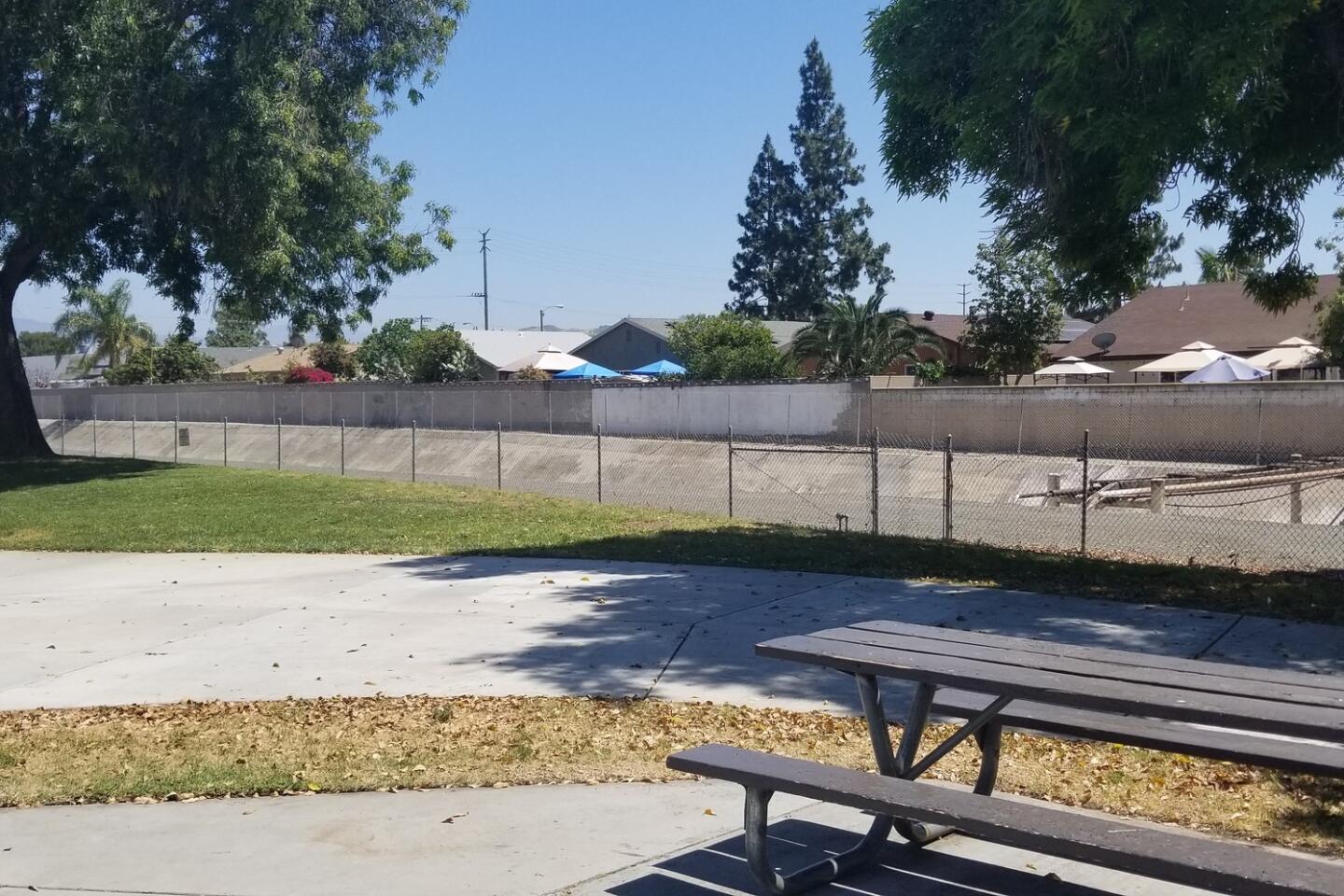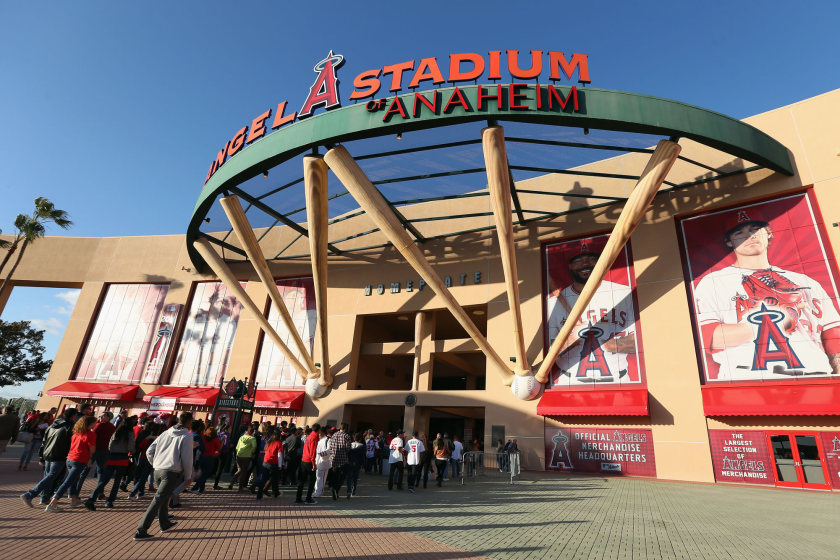Short film about late artist Manuel Hernandez-Trujillo leads to the restoration of his fading mural in the Atwood barrio of Placentia
- Share via
In the Atwood barrio of Placentia, there’s a 260 feet mural on a wall that lines one side of the community park. On it, there are pictures of orange trees, representing the orange groves where many Atwood families used to work to make their living.
There are images depicting the Mexican revolution and the 1938 flood that killed eight people in Atwood. There are conquistadors, Aztec eagles, serpents, jaguar gods, soldiers and a serene image of the sun.
For the record:
10:00 p.m. April 27, 2019A previous version of the story misstated the number of deaths in Atwood from the 1938 flood.
The last image is a giant butterfly next to a conspicuous 200 feet of empty white wall. The mural, painted in 1977, was never completed — the city said it lacked the proper permits.
This is the face of Atwood, says Joe Parra, a community leader born and raised in Atwood. His family has lived there since the 1920s.
“For years, it was a mystery who painted the mural,” says Parra. “Nobody knew. Everyone had a different idea what the mural meant to them.”
Since 2012, he’s wanted to restore it but kept running into hurdles. In 2014, he met Joshua Correa, an artist, minister and grandson of the city’s longtime advocate Rod Jimenez who had recently returned to Placentia after growing up in the city’s La Jolla neighborhood.
“We have a lot of problems in Placentia,” says Correa, pointing to a recent $5.3 million embezzlement. “I started asking people what is something that can bring the community together … get them to be a part of something that’s positive and not just constantly reacting to debt and scandal. What some of the community members kept on [saying] is, ‘You know we’ve wanted to restore that Atwood mural forever,’ and it was a representation of our history and heritage and it’s just fading like the morale of the community.”
Correa, who was the vice chair of the city’s Citizens Fiscal Sustainability Task Force, tried to leverage some of his government connections to no avail.
He explains that there was a nearby mural in downtown Placentia that was painted over because it was deemed radical. Without knowing the artist or the intent behind the Atwood mural, it was hard to convince the county that it was worth preserving.

In 2018, director Jacov Velasco began to adapt Manuel Gomez’s 2016 book “Dancing With The Sun: Artwork of Manuel Hernandez-Trujillo” into a short documentary. It was a part of a project called Memories of Migration, led by the Santa Ana History Room and History Pin, and the goal was to preserve the legacy of Santa Ana-based artist, activist and educator who was a force in the Chicano movement of the 1960s.
But by the time production of the film began, Hernandez-Trujillo was 85 and his health was failing. He’d had multiple strokes, he was wheel-chair bound, his voice was just above a whisper and Velasco was only able to film one interview with the artist before he died in August 2018.
Velasco had to step back and think about how to continue the documentary without its main subject. But then he remembered the first question he asked Hernandez-Trujillo.
“I asked, ‘Can you please introduce yourself to the camera?’ and he said no,” says Velasco. “He said, ‘I don’t introduce myself. I introduce my art form.’ … So we let the art speak for itself.”
Hernandez-Trujillo worked in multiple mediums — paintings, woodcut prints, posters and yarn paintings — but his most public works were his murals that not only illustrated local history but also depicted the struggles of the Chicano community and the injustices they faced.
Velasco and his filmmaking team set out to find and film all his existing murals.
A mural that Hernandez-Trujillo created in 1980 while he was teaching art at UC Irvine still sits at the UCI Irvine Cross-Cultural Center. Another, the Colonia Juárez mural in Fountain Valley, painted in 1976, had been whitewashed after it was tagged with graffiti.
And then there was the 1977 mural in the Atwood barrio of Placentia.
“The mural is so huge, it spans the entirety of the park,” says Velasco. “There’s no picture that actually captures all of it.”
Velasco was there interviewing “Dancing With The Sun” author Gomez — a community leader and friend of Hernandez-Trujillo’s who was a professor and Vice Chancellor of Student Affairs at UC Irvine before he retired — and Hernandez-Trujillo’s daughter Xóchitl Zuniga, when they realized their van had a flat tire.
As they were waiting for roadside assistance, they were approached by a local resident, who had gotten a phone call about suspicious outsiders that seemed to be loitering around the park.
Turns out the community protects the mural.
“Nobody’s ever graffitied it,” says Parra. “The golden rule is to respect the mural.”
Zuniga told the resident that she was the daughter of the artist, that they were filming a documentary about him.

Parra was disappointed to learn that Hernandez-Trujillo had recently passed away. But in February 2019, with newfound knowledge of the history of the mural — and the blessing from Hernandez-Trujillo’s family — Parra, Correa and Zuniga proposed a restoration plan to Placentia mayor Rhonda Shader, who was enthusiastic about moving forward.
But less than week later, in the early morning of March 4, Atwood residents woke to find that their beloved mural had been whitewashed.
Parra says that they got conflicting stories from the city and the county. First, they were told that there was an anonymous call about graffiti, then a story about how a inquiry about how to restore the mural was misinterpreted as a request to repaint it.
“After discussion with county staff, the city is confident that the painting over of the mural was an unfortunate mistake and is certain this was not done purposely by county staff,” says city administrator Damien R. Arrula.
He confirmed that the mural was accidentally painted over in early March by Orange County Public Works staff, but that they were able to remove the new paint in a couple days. However, the already faded mural was left more damaged.
Parra says it was hard for the community, because they recently lost two churches in the neighborhood. Their park, which used to be full of programs, is covered by dead grass. And now, the mural.
“So our community was feeling like, ‘You’re taking so much from us,’” says Parra. “So that’s why we’re hoping to rekindle those bridges with city hall and city officials and the county. So the mural can not only bring the community together but also repair our relations with the city.”
He says Frank Kim, the CEO of Orange County, personally called him to apologize to the community. Doug Chaffee and other members of the Orange County Board of Supervisors also personally apologized.
“In order to move forward, you gotta forgive,” says Parra.
The county has committed $10,000 to the restoration. But Parra, Correa and Zuniga are hoping to raise at least $5,000 more, because even though they plan to work with a team of volunteers, costs add up quickly.
“That would give us the flexibility to make sure it was sealed properly, and whatever money we had left over would go over to Phase 2, the [remaining] 200 feet to continue the mural,” says Correa.
Starting April 27, they’re bringing in local muralists to start the linework. Then, they hope to get adults and kids in the neighborhood to help paint it and eventually get everyone’s input on how to complete Hernandez-Trujillo’s mural based on their vision of Atwood’s future.
Correa is proud that it’s the community leaders leading the charge, with the support of the city, the county and arts organizations. They hope to complete it by Fall 2019.
And it all happened because of Velasco’s film.
“Had [we] not been there that day … and not gotten a flat tire, all these things when you think about fate and how everything happens for a reason, we never would have met,” says Zuniga, who says that her mother thinks it might even have been Parra’s grandmother who reached out to Hernandez-Trujillo to come paint the mural in Atwood.
“I’m a minister so that’s all God,” says Correa.
“I love how this little documentary can provide a little bit of momentum to help with a [movement],” says Velasco.
“Dancing With The Sun: The Artwork of Manuel Hernandez-Trujillo” plays at the Newport Beach Film Festival at 5:30 p.m., April 30 at the Triangle theater 6. For more information on the mural restoration and how to donate or volunteer, go to atwoodmural.com.
Support our coverage by becoming a digital subscriber.
For more news and features about Orange County, visit TimesOC.com or follow us on Twitter @timesocofficial.
More to Read
Get the Latinx Files newsletter
Stories that capture the multitudes within the American Latinx community.
You may occasionally receive promotional content from the Los Angeles Times.








